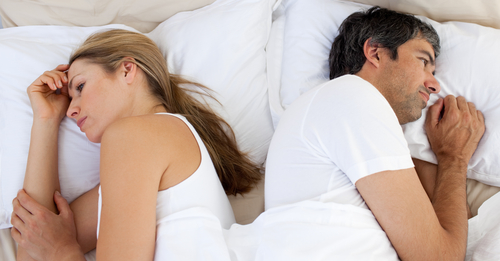
Study offers suggestions on what to do when sex is a pain in the back
By Sheryl Ubelacker The Canadian Press
Features Clinical Patient Care Sept. 10, 2014 – “Ow, my back!” They're hardly the words one wants to hear from a partner while having sex.
Sept. 10, 2014 – “Ow, my back!” They're hardly the words one wants to hear from a partner while having sex.
But for many people, intimacy in the bedroom often takes a back seat to low back pain, say researchers, who have scientifically determined the best sexual positions to prevent spinal muscles from seizing up at an inopportune moment.
In what they believe is the first biomechanical study of its kind,
researchers at the University of Waterloo have found that certain
positions are better than others for keeping different kinds of back
pain at bay.
And they've thrown out the long-held belief that
spooning – where partners lie sideways curled back to front – is the
only pose for back-saving sex.
“Before now, spooning was often
recommended by physicians as the one position that fit all. But as we've
discovered, that is not the case,” said Natalie Sidorkewicz, a PhD
candidate and lead author of the paper published Thursday in the journal
Spine.
“What that failed to do was recognize that there are all
sorts of triggers for back pain,” she said from Waterloo, Ont. “So
someone may find relief in one position that may cause pain for someone
else.”
To conduct the study, the researchers recruited 10
heterosexual couples, with an average age of about 30, to have sexual
intercourse in a controlled laboratory setting.
Each participant
was fitted with remote sensors, which tracked how their spines moved
when they engaged in five common sex positions. Infrared and
electromagnetic motion capture systems – such as those used to animate
figures in video games and films – showed how the men's and women's
spines flexed when they assumed each position.
“So we were able
to actually determine what angle the spine is at, at each moment in time
that they're having sex,” said Sidorkewicz, adding that electrodes on
participants' skin also captured activity in their core and hip muscles.
The
findings were used to create an atlas, or set of guidelines, that
recommends different sex positions and thrusting techniques based on
what movements trigger a patient's pain.
Overall, the study found
both men and women employ a lot of spinal motion during sex, said
Sidorkewicz. “In general, to make any position more spine-sparing, we're
recommending that the individual who's controlling the movement use
more of their hips and knees, rather than their spine,” while their
partner keeps a more neutral supine position.
“A great example of
both these recommendations is the missionary (position),” she said,
advising that a woman lying on her back place a cushion or other support
under the curvature of her spine.
The researchers also found,
for instance, that kneeling behind one's partner during intercourse can
prevent back pain caused by flexion in both partners.
“Any family
doctor will tell you that couples often ask them how to manage their
back pain during and after sex,” said senior author Stuart McGill, a
professor in the faculty of Applied Health Sciences. “Many couples will
remain celibate because one night of love-making can lead to months of
back agony.
“Until now, doctors have never had any hard science to base their recommendations upon.”
And
having a bad back that interferes with one's love life is more common
than many people realize. Survey studies suggest that 84 per cent of men
and 73 per cent of women report significant decreases in sexual
relations due to lower back pain, Sidorkewicz said.
“Right now,
if a patient were to come to a chiropractor, physiotherapist or a
physician asking for resources on this, anything that is currently out
there is not based on scientific data,” she said.
“So we are now
providing that to help guide those clinicians to make better
recommendations for those patients. So the idea is to improve the
quality of life of these couples by helping them maintain more of a
healthy sexual relationship.”
Although this study focused on how a
man's spine and muscles move during intercourse and orgasm, the
scientists also gathered data on female participants, which they hope to
publish later this year or early next.
Future papers include
similar studies on people with existing back and/or hip pain to test the
effectiveness of their initial recommendations, which would then be
further refined for various patient groups.
The guidelines should
also help doctors and other health providers feel more comfortable
about discussing the delicate topic of sexual positions, Sidorkewicz
said.
“We're hoping to help facilitate that dialogue between the
patient and practitioner and also between couples who are struggling
with this daily.”
Print this page